Audi Entertain Vision
Bachelor thesis

Timeline
24 Weeks
February - August 2019
Project type
Bachelor thesis project
My role
UX Design student trainee
Tools
Microsoft Project and Excel,
Adobe Suite, Unity, C#
Skills
Project Management, UX Research, UX Design, Interaction Design,
Unity Prototyping, Virtual Reality Prototyping
Outcome
bachelor thesis, requirements catalog, wireframe concept, interaction prototype and visual design
Audi Entertain
is a vision concept for the entertainment experiences of autonomous Audi vehicles
01 Overview
During the last semester of my bachelor studies, I got the chance to write my thesis in cooperation with the Audi Electronics Venture HMI team. The goal of my thesis was the elaboration and development of a holistic vision concept for the future entertainment experiences of autonomous Audi vehicles. The thesis was my biggest project so far and was graded with excellence. (1.0) A special thanks to my mentor at Audi, Dr. Stefan Mayer, the whole HMI team and my professor Ingrid Stahl!
Some restrictions
Non-disclosure agreement
Since I was on an incubation team, all of my work is tented - aka under a non-disclosure agreement. Nevertheless, I am allowed to show some parts of the project to communicate what I was working on and what I’m capable of. Some of the shown pictures are in german, so don't be surprised.
What should we do
with the newly gained time?
02 Problem
It is only a matter of time until fully autonomous vehicles will be part of our daily lives. Now the question arises, with what will the people engage during this newly gained time on the road. On this topic, Audi conducted some research and found out that around 30% of the answers were related to Entertainment, yet there was no concrete concept for it so far.
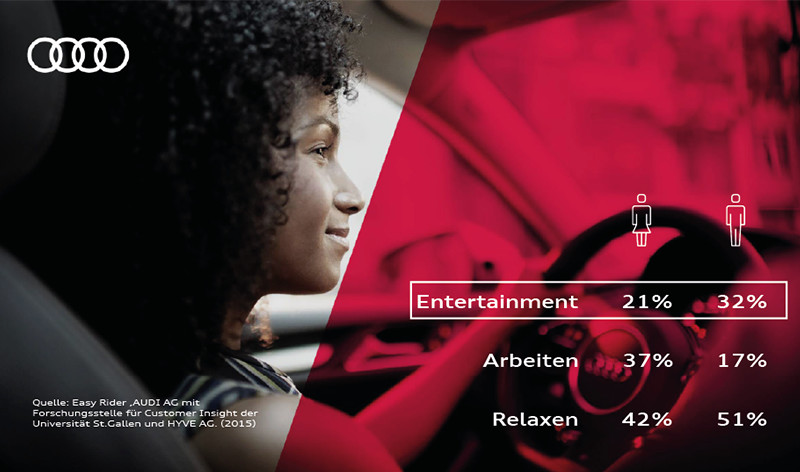
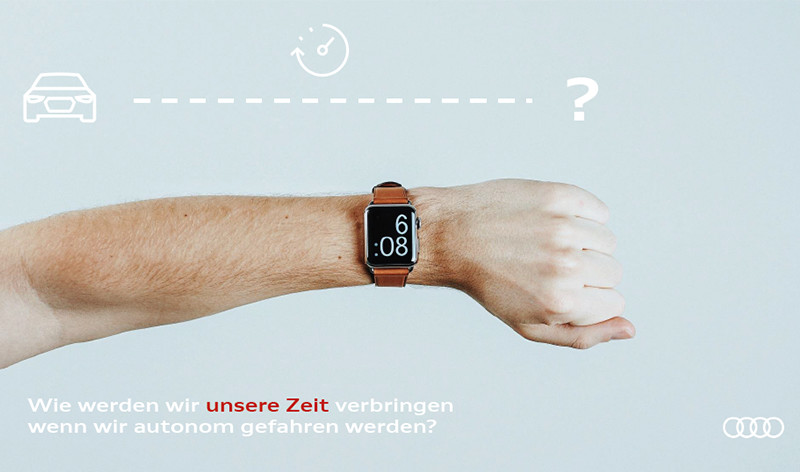
Challenge accepted
It was quite a ride!
03 Challenge
Before this project, I mostly designed for specific hardware pieces. For example, if you design an app you know it will be running on a phone or tablet. Now with this project, I had no reference at all. I needed to create a prototype for a complete interface and operating system from scratch, for autonomous vehicles that aren’t even produced yet.

My motivation Post-It - "Just do it"
Follow the process
It is your friend
04 Process
The development of the Audi entertain vision is based on the user-centered design process. For a detailed overview of the steps and used methods of this project, the UCD process was divided into the different subdivisions below. The individual phases were carried out in an iterative pattern to further refine the respective results
Process steps
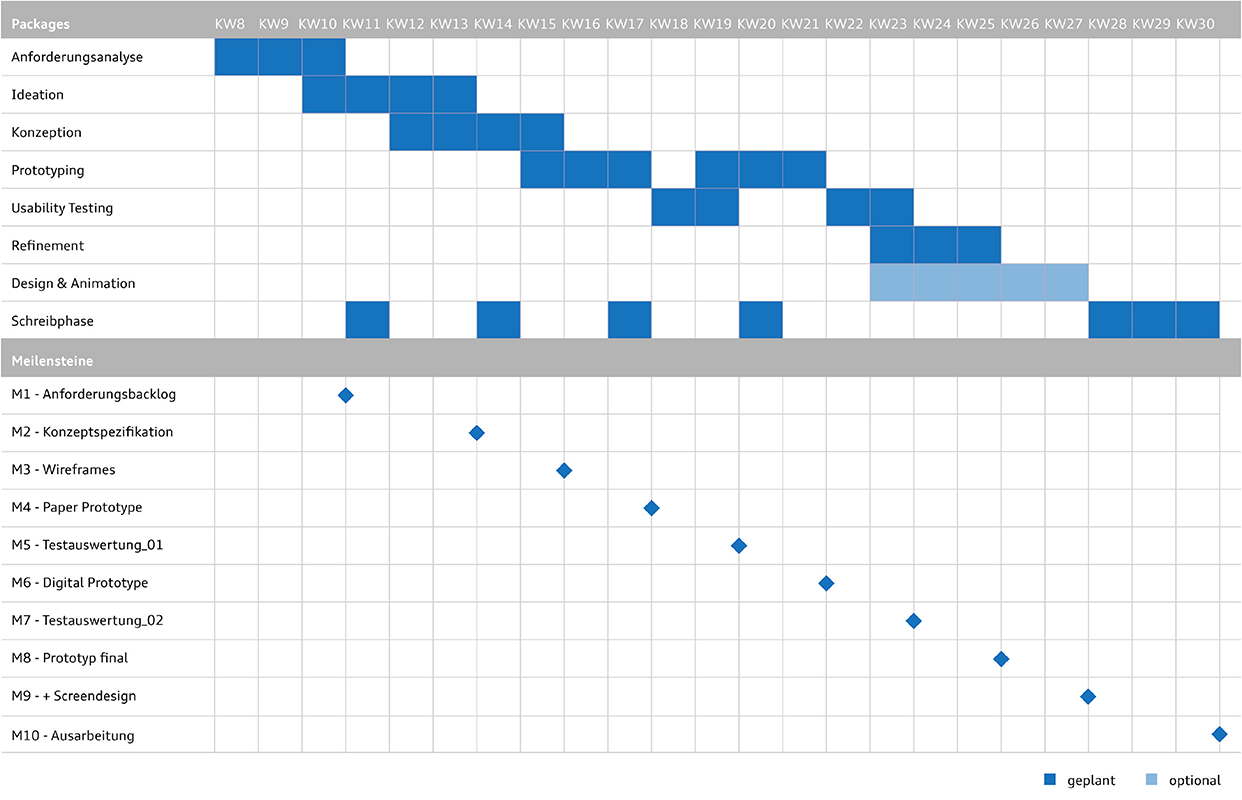
Project plan
Building the foundation
Analysis
05 Analysis
As a first step in the requirements analysis, several sub-analyses were carried out to gain a broad overview of the topic of entertainment for autonomous driving.
Context Analysis
Automated driving
Automated driving is classified into six levels in Europe according to SAE International. Only the last two levels 4 and 5 have importance for this project, because they allow the driver to fully engage with other things while driving, such as entertainment.
SAE International - Levels of automated driving
Context Analysis
The brand Audi
The entertainment vision concept is intended to reflect the Audi brand profile. The goal is to create a clear differentiation to other brands and stand out from the competition through it.
Self-image
"Audi stands for sporty vehicles, high quality work, and progressive design
Corporate strategy
“Audi is driving the megatrends Sustainability, Digitization and Urbanization as Pioneer ahead."
Brand strategy
“Being ahead means more personal freedom - Audi wants to network, simplify and surprise.”
Entertainment & Experience
Interview findings have shown me that users mostly differentiate entertainment and experience form each other. For them, entertainment is related to passive reception of information. An experience, on the other hand, is related to active participation. I was looking for the intersection of those two and found out that entertainment can be an experience through Immersion and emotional engagement.
Target group analysis
To develop a user-friendly and suitable entertainment concept for the future Audi drivers, I need to have a precise understanding of the potential Audi Entertain target groups. With the use of the SIGMA and DELTA social milieu model and the beforehand acquired knowledge about the Audi brand, I could define three special target groups for my vision concept.
DELTA social milieu model - Audi Entertain target groups
Experimentalist
Young - Urban - Creative
The explorer of new worlds and identities
Liberal Performer
Liberal - Cosmopolitan - Efficient
The performance elite with global orientation and progress optimism
Individual Intellectual
Individual - reflected - enlightened
The educational elite with an individualistic attitude
Environmental analysis
I also took a detailed look at Audi’s current autonomous concept the Audi Aicon. The goal was to get a system and interaction wise reference, which should be used as inspiration for the entertain concept.

Audi Aicon interior interfaces
Benchmark Analysis
Lastly, I conducted a benchmark analysis to identify possible solutions from the competition. It is based on three sectors, each with an explicit focus on entertainment. The first sector was a dedicated automotive benchmark analysis. The second sector deals with rail transportation and the third with flight transportation.

Benchmark map automotive
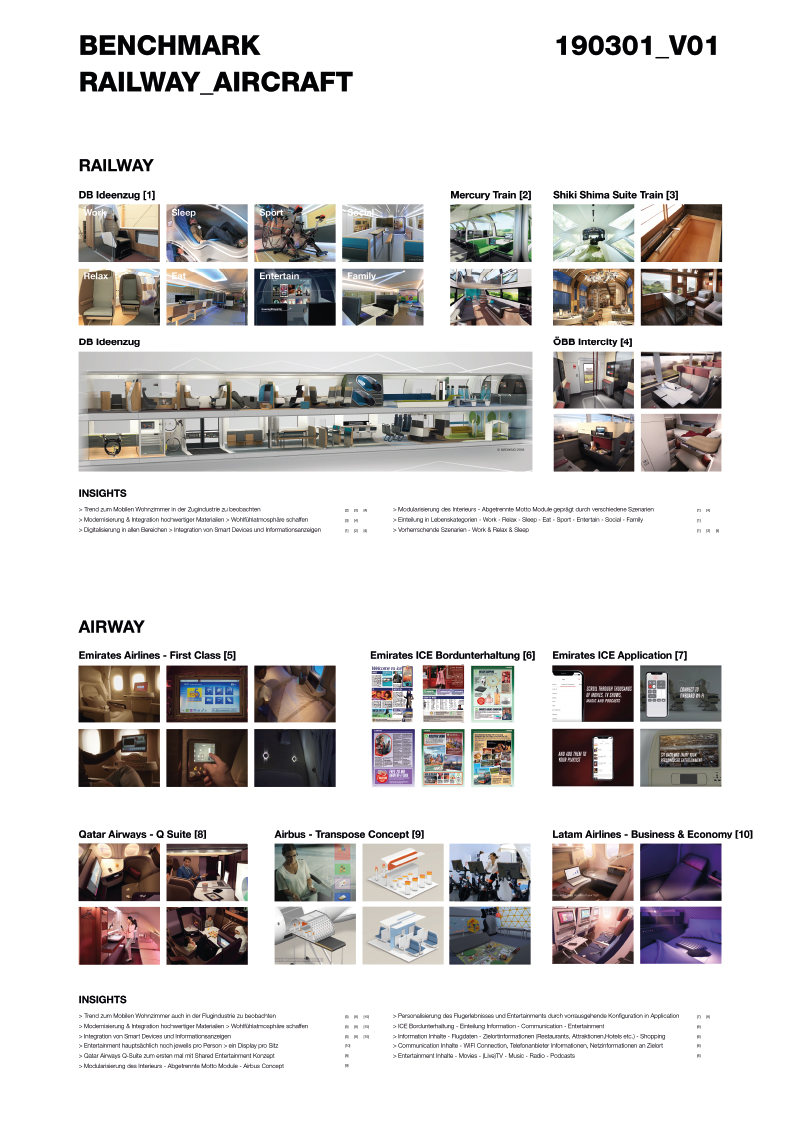
Benchmark map railway and airway
Requirements catalog
small and simplified
06 Requirements
After synthesizing the gathered information, I was able to generate a comprehensive requirement backlog, which the Audi entertain vision should fulfill. Unfortunately, I can only show a very simplified overview of the most important requirements below.
Include personality
and profile
Consider situation
and context
Include mood
detection
Enhance multimodal
perception
Strive for
immersion
Enable social
experiences
Design open for
third party
Include personal
digital assistant
Include personality and profile
Consider situation
and context
Include mood
detection
Enhance multimodal
perception
Strive for
immersion
Enable social
experiences
Design open for
third party
Include personal
digital assistant
Generating Ideas
Ideation
07 Ideation
To convert the knowledge into a concrete concept, the next step was an ideation. Firstly, I defined three different user personas that are characterized according to the Audi entertain target groups. Additionally, I made use of the sensation seeking scale by Marvin Zuckerman to achieve a clearer picture of what kind of entertainment activity each persona may prefer.
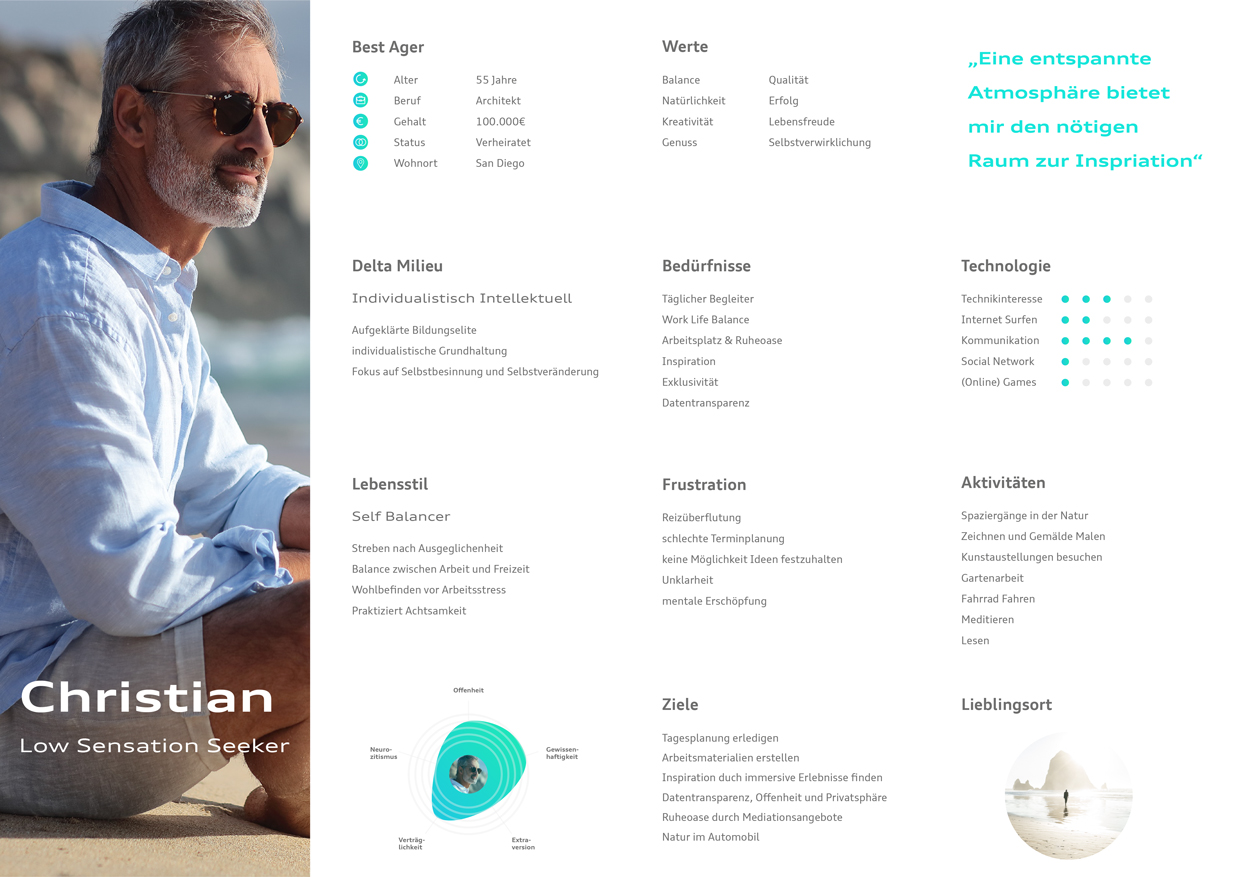
Persona Christian

Persona Kim
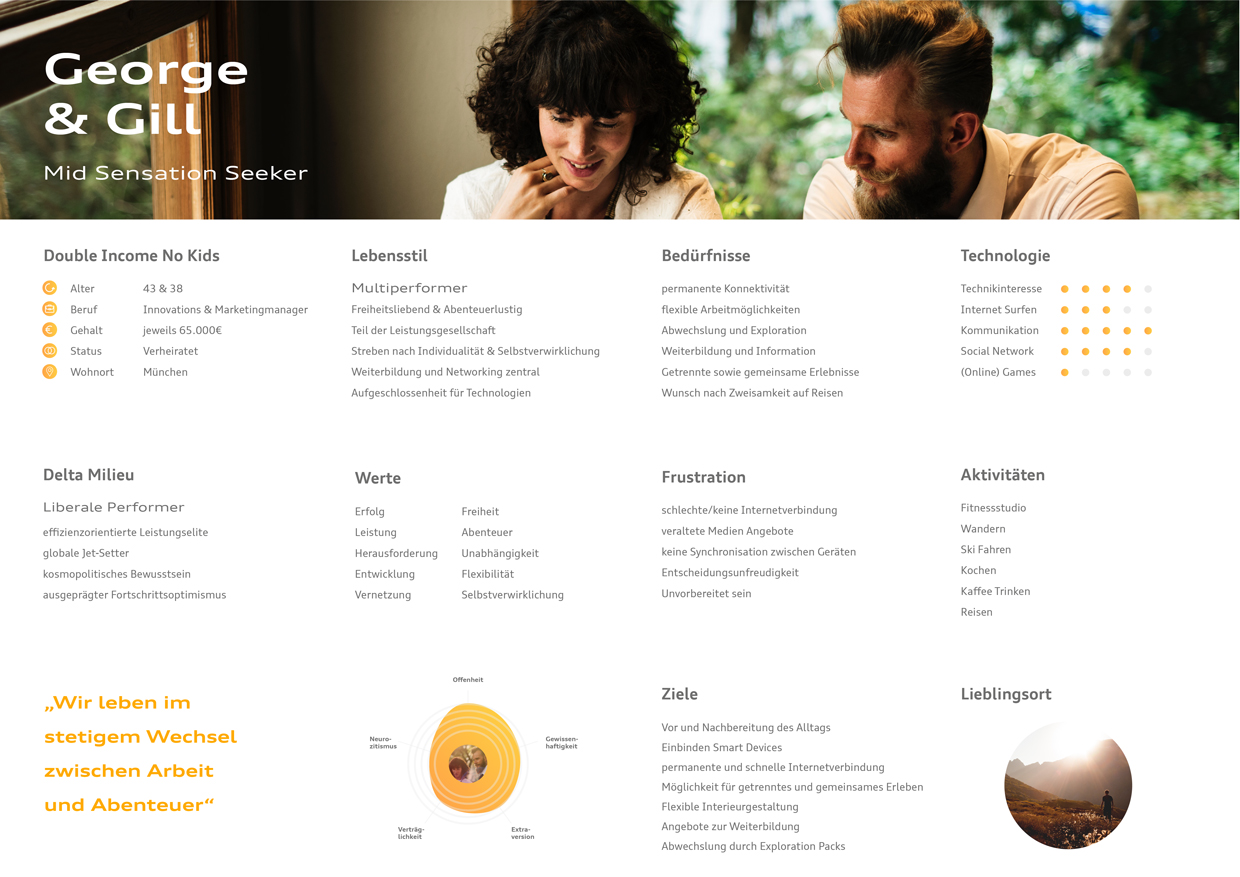
Double Persona George & Gill

Sensation Seeking Scale
Selecting Experiences
To come up with possible entertainment activities for each persona, we did a brainstorming session together in a team. Following we categorized the activities according to the Pine and Gilmore experience model in an affinity diagram and decided which activities to include inside the entertain concept.
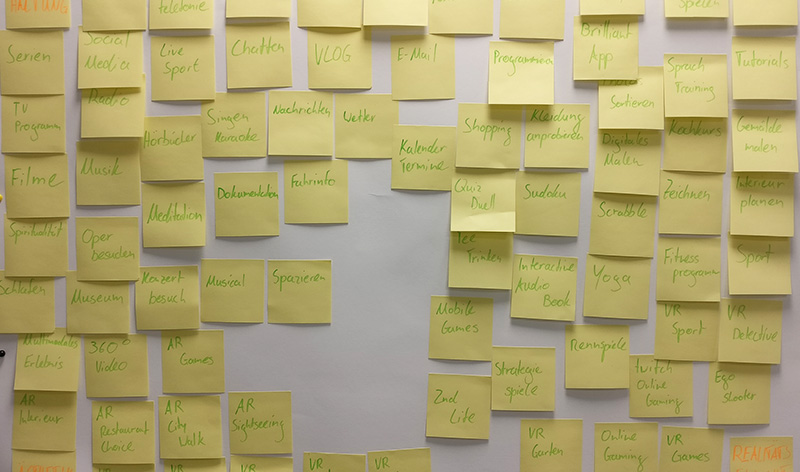
Affinity map of brainstormed entertainment activities
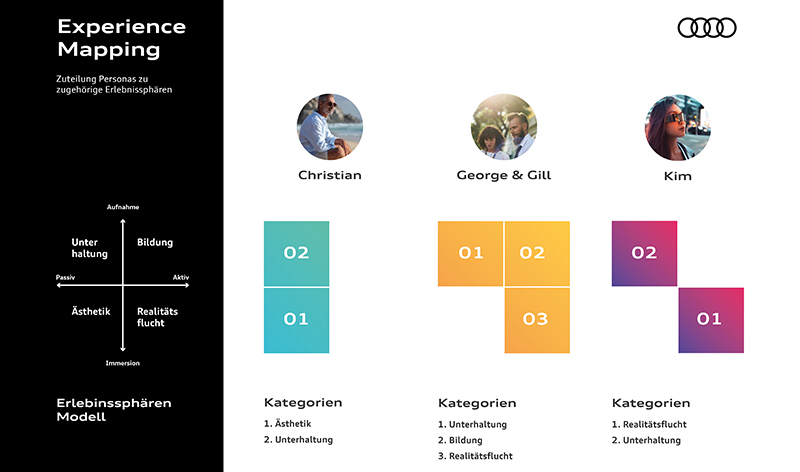
Entertainment activity mapping for each persona according to Pine and Gilmore
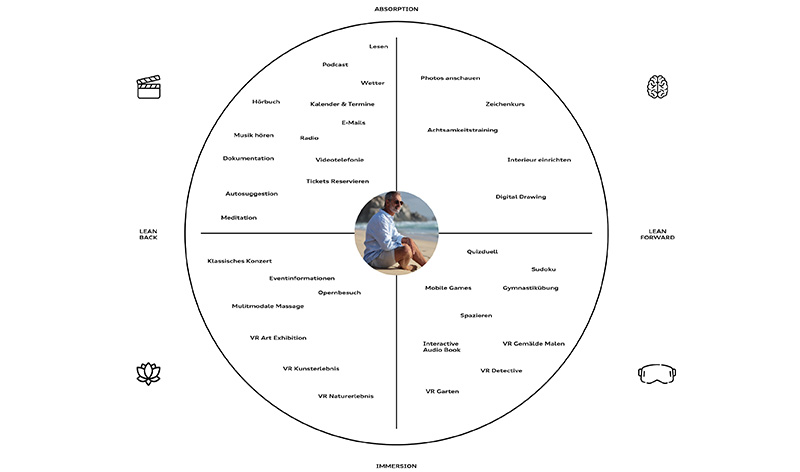
Ordered activities for each persona according to Pine and Gilmore
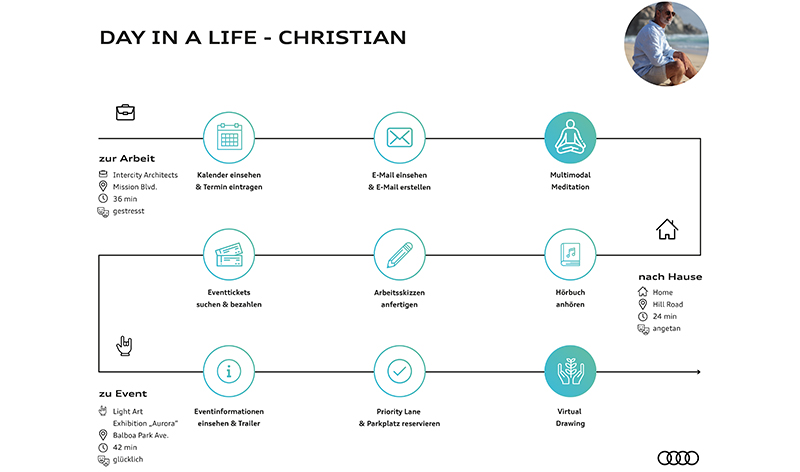
Day in a life user stories
Concept structure
Creating a clear vision
08 The structure
After gathering a lot of ideas and insights throughout the analysis and ideation, I created the structure for the concept. It is put together by three display interfaces and a virtual reality glass. Special about this concept is the removable tablets inside each door. This allows both passengers to either enjoy entertainment on their own or interact with each other. Unfortunately, I can't provide any deeper information or visuals here.

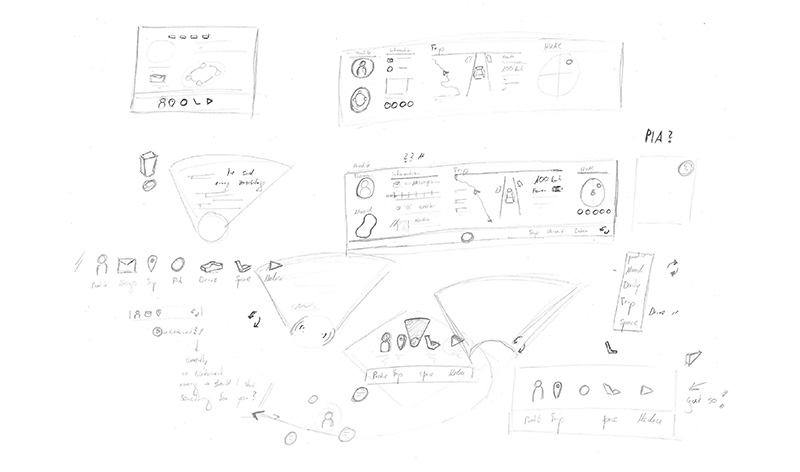
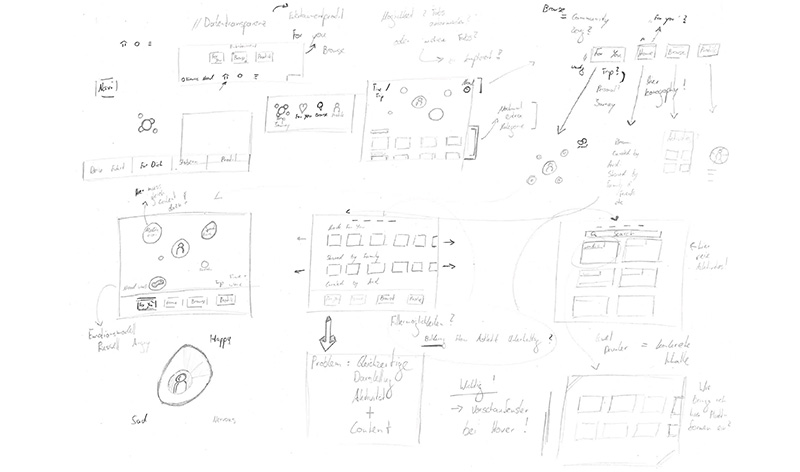
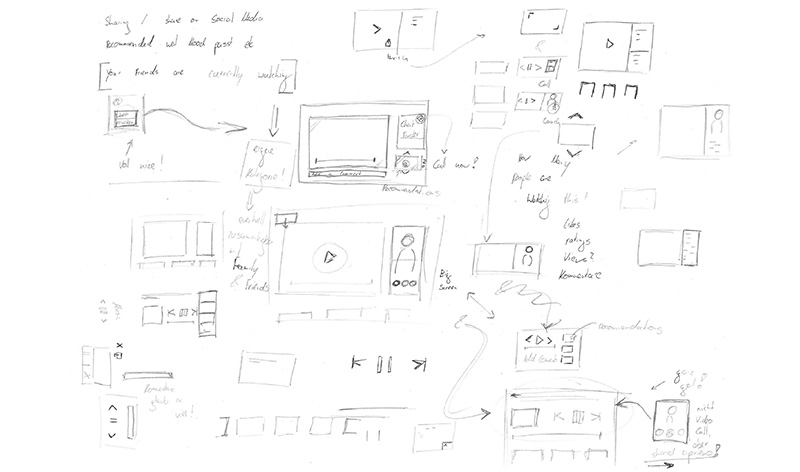
Just some scribbles and sketches of the concept phase
Paper Prototyping
That rapid stuff
09 Paper and Evaluation
As the first conceptual step, I produced various paper prototypes of the Audi entertain concept. After rapidly reviewing and refining them, I decided to conduct a first usability testing with the Paper Prototype to see if the system and also the concept structure is going in the right direction.
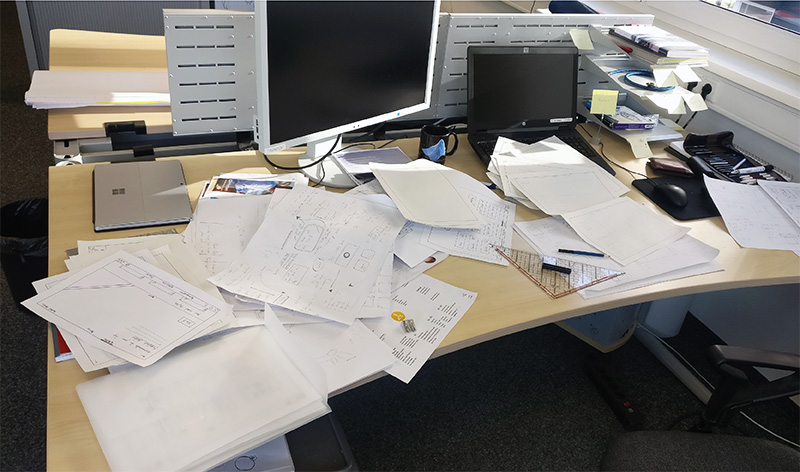
Early sketches
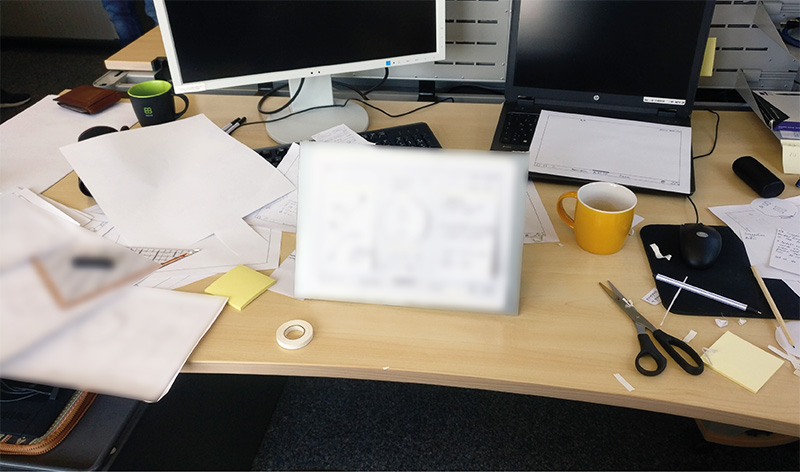
Tablet paper prototyping
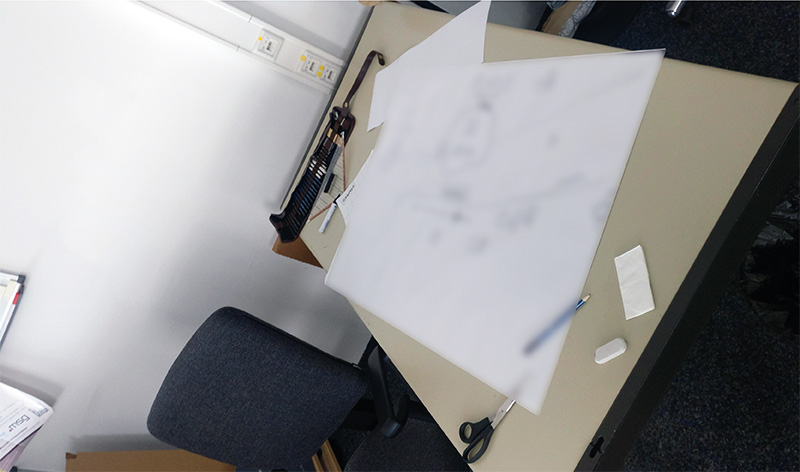
Windshield display prototyping
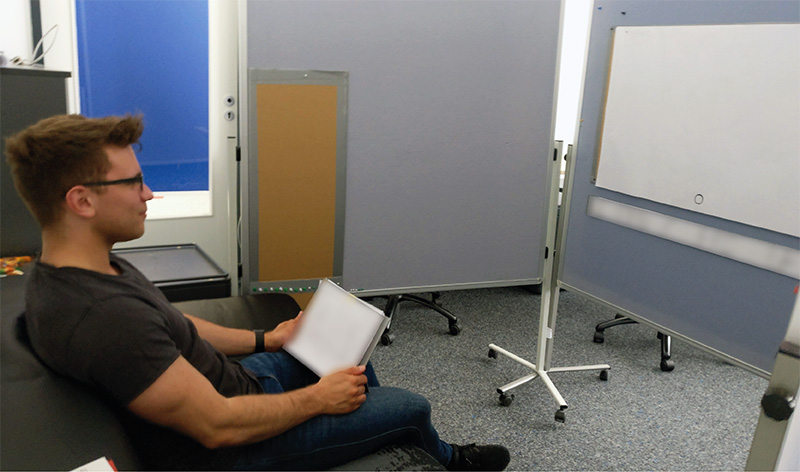
Usability testing
Digital Development
Building a digital interaction prototype
10 Digitalization, Development and Evaluation
After finishing the first testings, I refined the concept and digitalized everything as wireframes. After that, I built a first interactive prototype inside of Unity. I especially chose Unity because it offered me the needed tools to create this holistic entertainment concept. Especially important was to connect the different tablets, monitors and virtual reality applications over TCP-Sockets, so that each interface could interact with one another. I then integrated the whole concept inside a self-built car simulator and tested it again in a second usability testing.
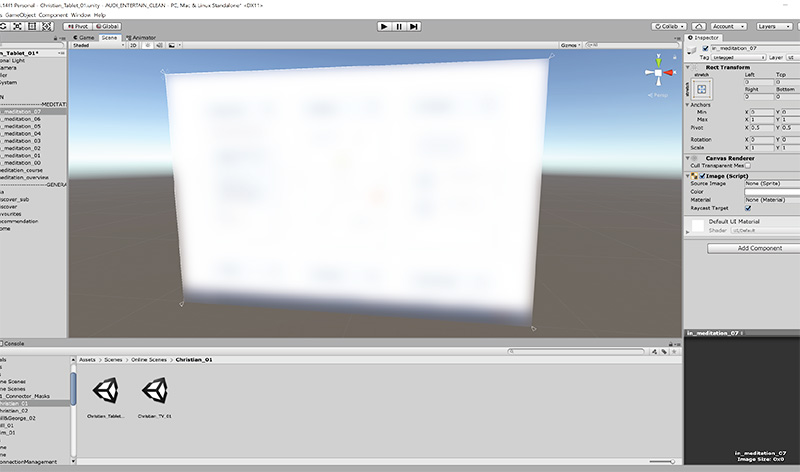
Unity development tablet prototype
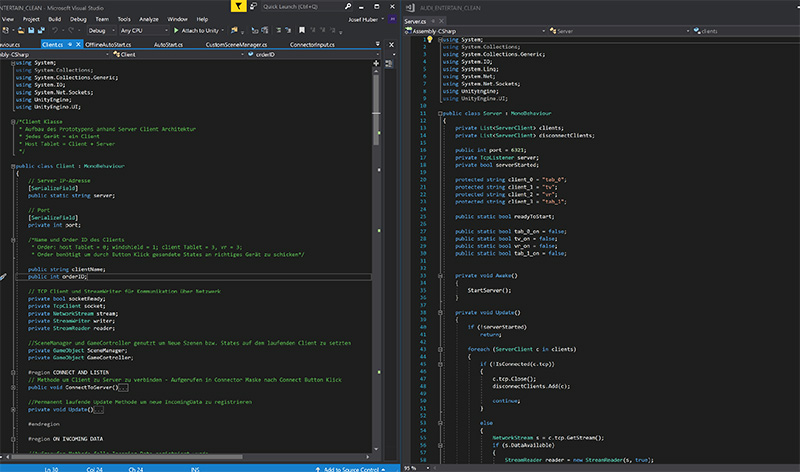
Writing my own unity client-server architecture
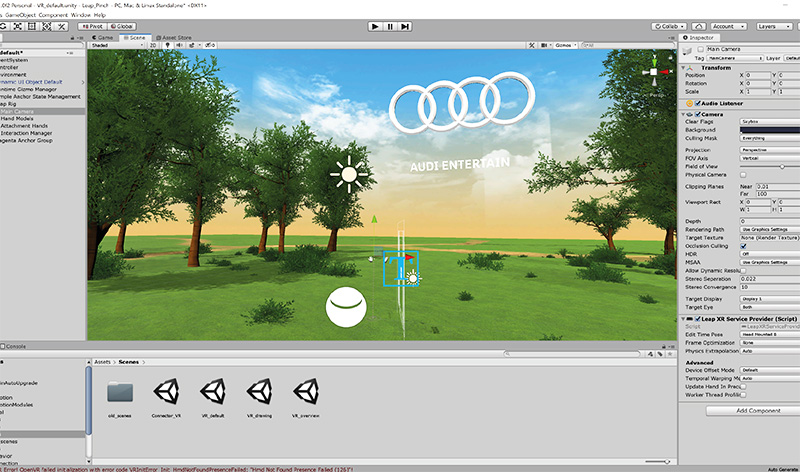
Unity development virtual reality use case

Unity development windshield prototype
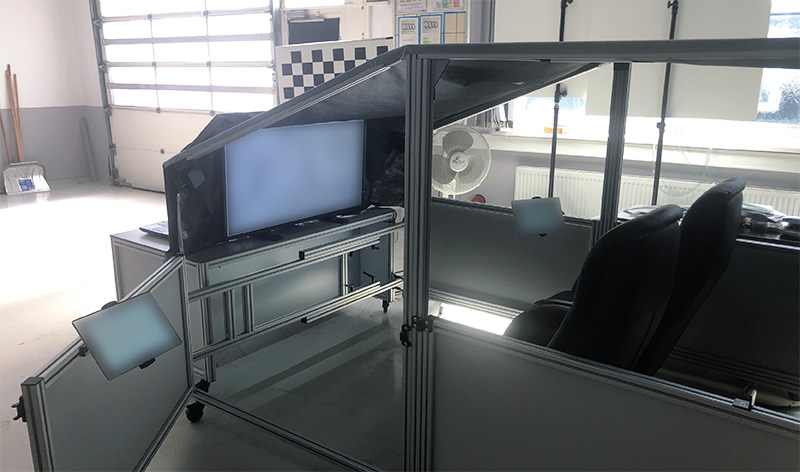
Interaction prototype integrated in car simulator
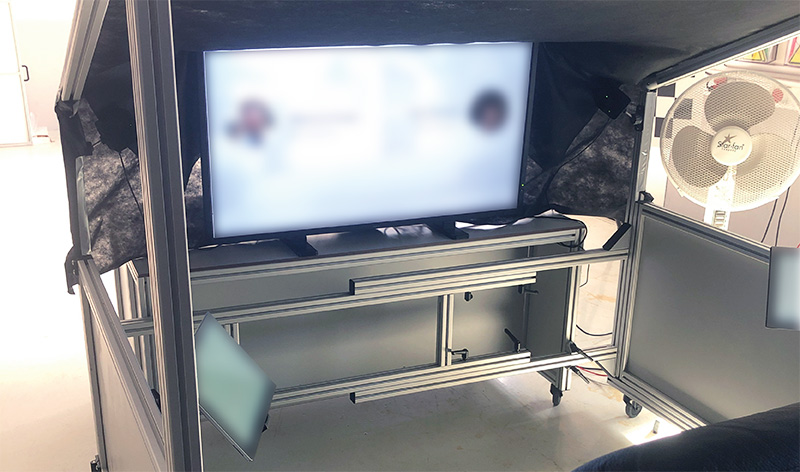
Final setup

Improvised virtual reality setup
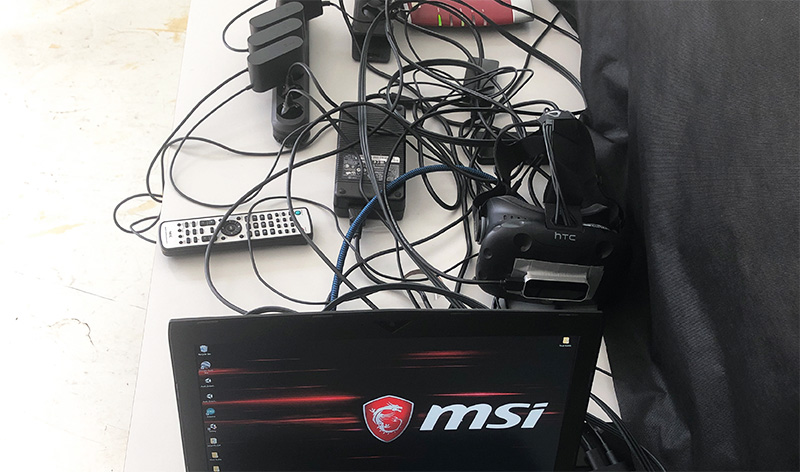
Just some of the needed technology
Visual Design
The look and feel
11 Design
After refining the wireframes according to the user feedback, I began thinking about how the concept would look and feel. One of the requirements was the personalization of the system. This should also be reflected in the UI design. Therefore, three different mood boards were created for each Persona, to get a visual reference in which way the design could be heading.
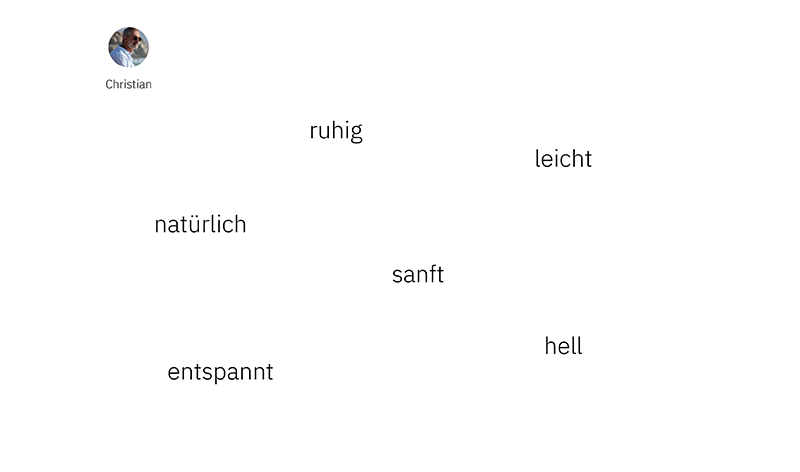
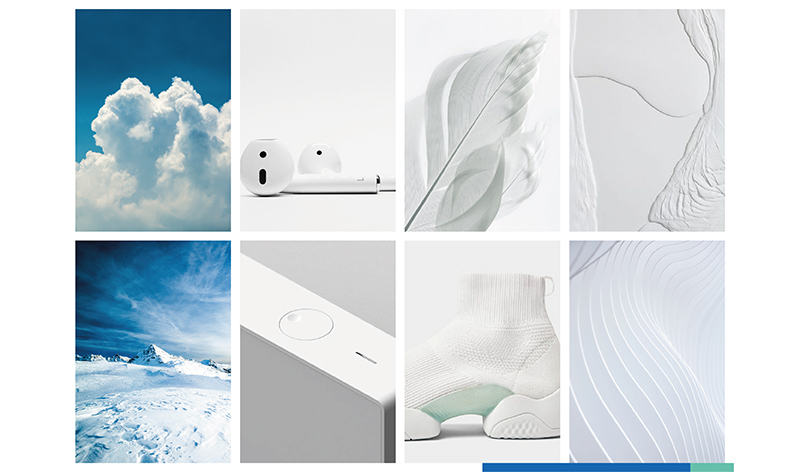
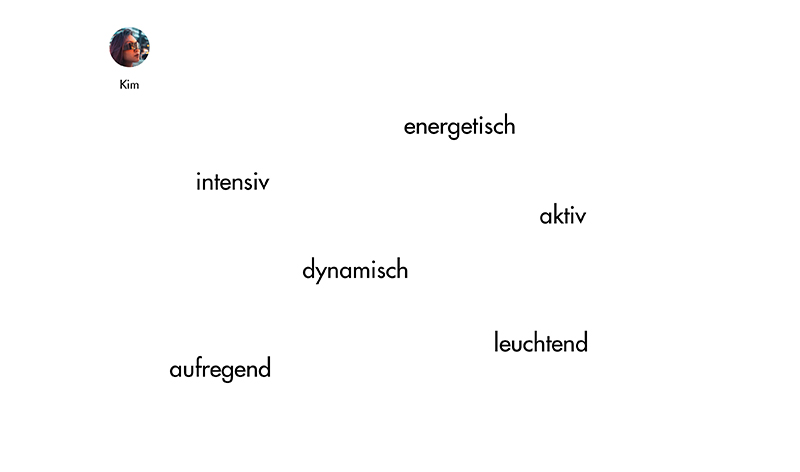
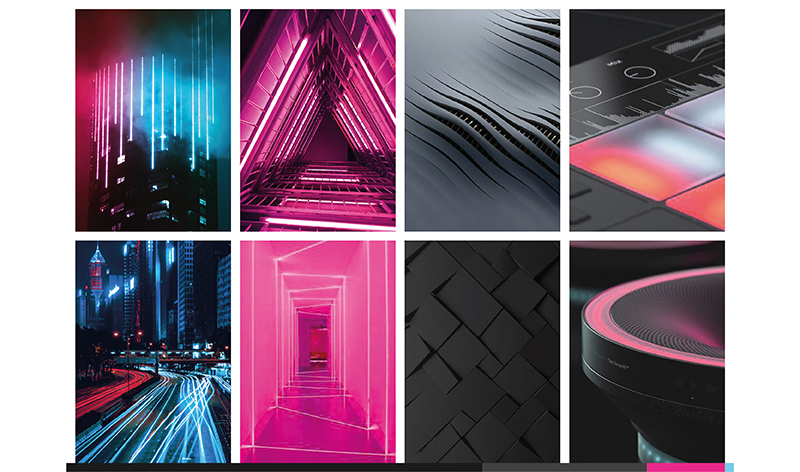
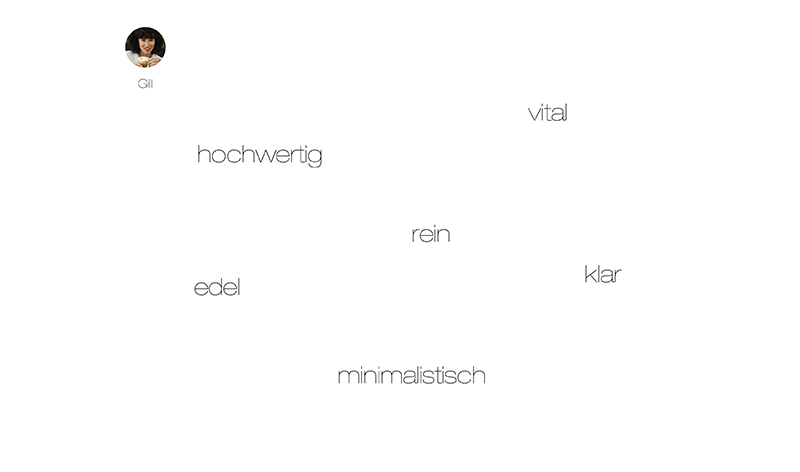
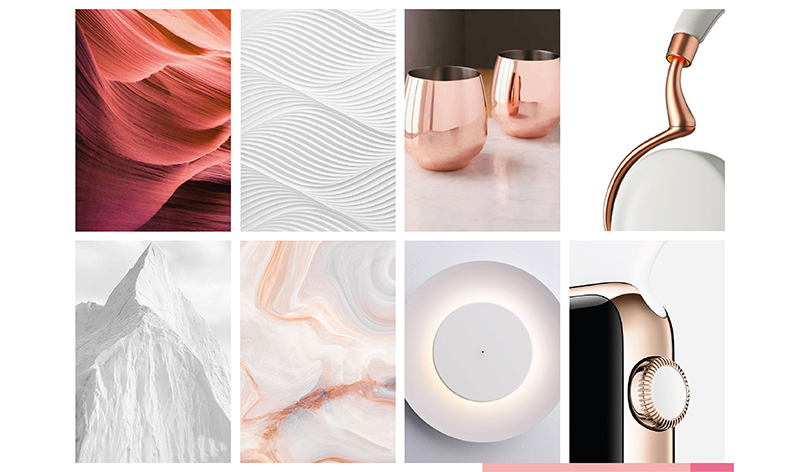
Lessons learned
It was a lot
12 Lessons learned
Through this project, I learned to organize myself in a better way. How to set up a project plan over several months and follow milestones was something I took away from it. Also wrapping your head around a concept that may be first accessible in 10 years and creating a tangible vision for it right now, was something I had to figure out at first. Developing and prototyping this holistic entertainment concept over several displays with an endless number of interconnections, different technologies, and various input modalities, also helped me to always have the bigger picture in mind.
Still curious?
Check out some of my other projects
An approach to an all in one travel companion
Tripster - case study
I developed a concept for a mobile application, The goal was to enhance the trip experience by providing personalized travel sight and event recommendations. This project includes mainly UX research, UX design, and visual design.
PERSONAL PROJECT • 4 WEEKS • OCT 2019 • READING TIME 10 MIN
Concept for ecological grocery shopping
Eco - case study
In the first semester of my master's studies, we developed together in a team an app concept for the future of ecological grocery shopping. The project was mainly focusing on UX Design, Visual Design and Motion Design.
STUDY PROJECT • 16 WEEKS • MAR 2020 • READING TIME 10 MIN